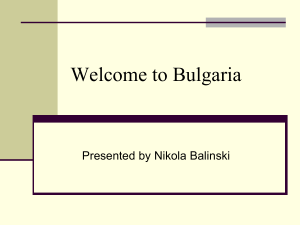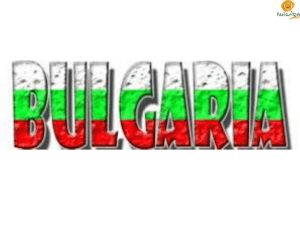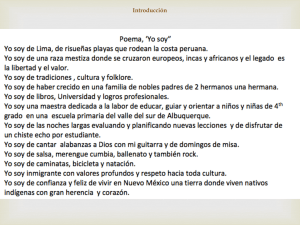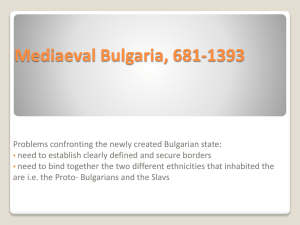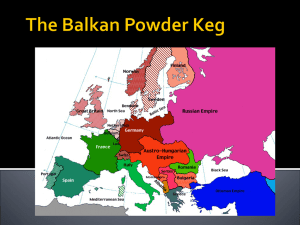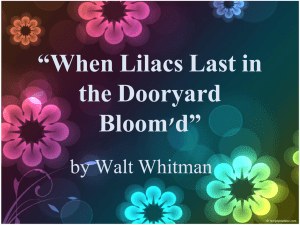Manastir Kilims - R. John Howe: Textiles and Text
advertisement
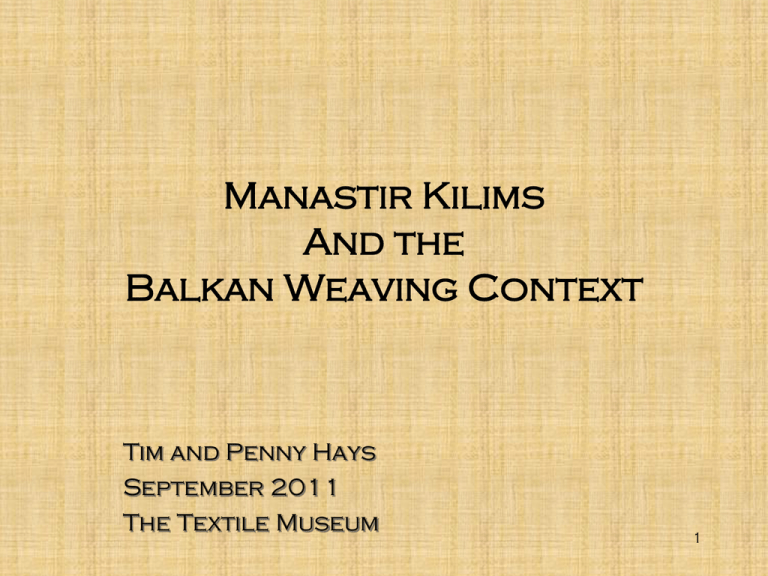
Manastir Kilims And the Balkan Weaving Context Tim and Penny Hays September 2011 The Textile Museum 1 Manastir Kilims And The Balkan Weaving Context Weaving Took Place Across the Balkans Dalmatia (Croatia) Romania Bessarabia Serbia Bulgaria Bosnia-Herzegovina Macedonia 2 EASTERN EUROPE 3 Kilim Weaving Centers Western Balkans and Western Bulgaria: Urban and Organized Pirot (Serbia) Vojvodina (Serbia but more rural than Pirot) Chiprovtsy (Bulgaria) Macedonia The above are collectively known as Sarkoy in the trade and among collectors Romania (Oltenia and Moldavia) Romania (Maramures,Banat, Hunedora: these Areas more Rural) Bessarabia (Moldova and Ukraine) Bosnia-Herzegovia (especially after 1878) 4 Production Types Eastern Bulgarian Weaving Manastir (Bulgaria) Rural, individual weavers Pomaks (Bulgaria/Turkey) Rural, individual weavers Kotel (Bulgaria) Urban and organized Weaving design, technique, and motifs have more Anatolian influences 5 ROMANIA Walachia - Moldavia - Transylvania 6 Bulgaria 7 Bulgaria 8 Religious Background Of The Weavers Orthodox and Roman Catholic in Romania, Bessarabia, Western Bulgaria and Serbia Areas of mixed religious practice and ethnicity in the Balkans Muslim in Eastern Bulgaria, Macedonia, and Bosnia Mostly Sunni In Eastern Bulgaria a significant number were Bektashi and Alevi 9 THE MANASTIR WEAVING CULTURE The Manastir Heartland was Eastern Bulgaria The weavers were descendants of Yoruk and Turkman (Kizyl Bash) immigrants from Anatolia, resettled to this area by the Ottomans Many Bektashi and Alevi Re-immigration to Western and Central Anatolia probably began in the late 1870’s May have begun as early as the mid-1850’s (Russo-Turkish war) 10 THE MANASTIR WEAVING CULTURE Manastir weaving occurred in both Bulgaria and in several areas in Anatolia In Bulgaria, production of flatweaves was the norm: Prayer kilims Geometric ‘eye-dazzler’ and striped kilims Blanket-weave covers (striped) Non-directional kilims (various sizes) Kilim yastiks in prayer and non-directional formats Bags and trappings not known Earliest West Bulgarian kilims were geometric. Sarkoy group began late 17th and 18th century Earliest Manastir weavings known are early- to mid19th Century (per Velev and Stankov) 11 MANASTIR WEAVING TECHNIQUE Blanket weave Plain weave Tapestry Slit tapestry Brocading Only occasional use of eccentric wefting which was much more common elsewhere in the Balkans Wefts sometimes of different diameters in a single piece Warp threads are wool or cotton but always very tightly spun. Goat hair known in Sarkoy weavings Weft threads always wool, some cotton after turn of the 20th Century. Vertical looms Eastern Bulgarian weaving is distinctive. Differs from that 12 of western Bulgaria and the urban weaving centers MANASTIR WEAVING MOTIFS AND DESIGNS Stripes Prayer arches (often floating) Protective amulets Hands of Fatima Multiple compartments Generally sparsely filled open fields of solid colors Designs are often austere and somewhat archaic Pre-1925 kilims were not the product of organized weaving 13 Manastir Weaving Color Schemes Manastir weavings from Bulgaria and Anatolia have similar colors, but probably have different dyestuffs Bulgarian production may feature: Red from Balkan kermes or cochineal Woad blue Yellow (weld or fustic) Anatolian production seems to utilize colors typical of the areas to which the weavers relocated: Red from madder Blue from indigo Yellows from one of several yellow dyestuffs More contemporary weavings from this group are synthetic versions of the original color scheme 14 Manastir Weaving Color Schemes Generally fields in Manastir kilims are yellow, red, or blue Manastir kilims made in Balkans use woad rather than indigo. The actual dye chemical indigotin is the same Greens are woad blue overdyed onto yellow Many shades of red ranging from pale pinks, purple reds, to brick red. Possible use of beet root, rose root, cherry skins Yellows are mustard through wheat Yellow not used in weaving by Slavic Bulgarians Light sensitivity and color fastness vary considerably Wefts are white wool, or cotton and warps are white and brown wool and cotton (or a mix) – cotton generally indicates later production Goat hair Warps? Sometimes in Sarkoy pieces from West Bulgaria 15 Mosques in the Manastir Heartland Ali Pasha Mosque in Razgrad Tombul Mosque in Shumen In Razgrad small Manastir prayer kilims were observed in use in the Women’s Gallery These are two of the three largest mosques in the Balkans Area is known to be populated by non-orthodox Muslims even today 16 The two slides that follow are of the images of the Bulgarian countryside in the Balkan mountains north of Pirot, Serbia and Chiprovsty, Bulgaria. This is the landscape which supported the original Yoruk and Kizlbash Turkmen during the period of Ottoman dominance (pre-1878). Stari Planina 18 Stari Planina 19 The image that follows is of the town of Chiprovsty, Bulgaria, one of the main weaving towns in contemporary Bulgaria. Kilims made here are a contemporary version of the Sarkoy type. Chiprovski 21 We hope to obtain photos of the Manastir production areas of northeast and east central Bulgaria during a Fall, 2012 research trip. This is the end of the lecture. Now we’ll look at the examples in the room. 23

